Agapanthus Plants
Where to Buy Online
- Queen Mum™ – Agapanthus orientalis
- Bingo White™ Agapanthus hybrid ‘WP001’ PBR
- Bingo Blue™ Agapanthus hybrid ‘ANDbin’ PBR
- Buccaneer™ Agapanthus hybrid ‘AMDB002’ PBR
Agapanthus Colours
Queen Mum™ – Features extra large white and blue flowers.
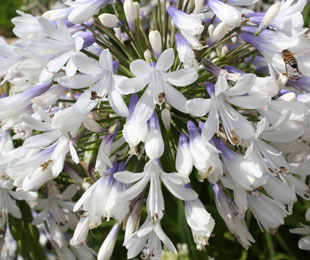
Bingo Blue™ – Features bright blue flowers.
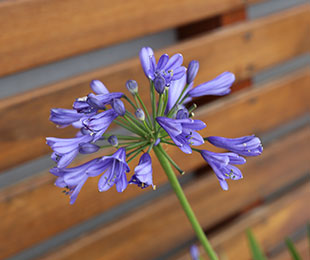
Bingo White™ – Features bright white flowers.
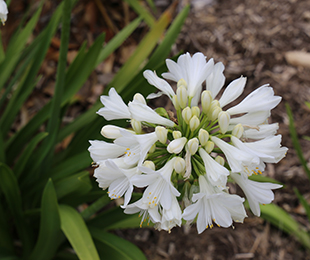
Buccaneer™ – Features unique white flowers with purple stripes.

Agapanthus Hedge Height
Queen Mum™ – Grows up to 1.5 metres

Bingo White – Grows up to .8 metre
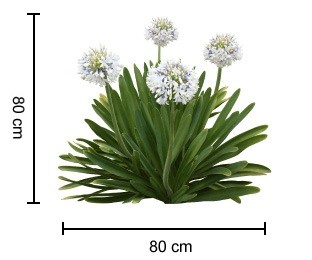
Agapanthus Flowers
Repeat flowering Agapanthus for up to 6 months of the year. The small window of flowering for an Agapanthus plant often hinders its popularity among landscape professionals. This has changed with Ozbreed’s repeat mass flowering Agapanthus varieties.
These gorgeous plants produce masses of bright and colourful flowers in spring and summer, as well as sporadically throughout the year, including in mild winters as seen in 2020.
Our Agapanthus varieties are designed to be tough enough to brave the Australian landscape, with good disease resistance, and drought and frost tolerance.
About Agapanthus
Agapanthus plant, with its deep green soft fleshy leaves and distinctive vivid blue, white or purple flowers perched on tall thin stems makes a very impressive summer showing in gardens throughout Australia.
There are a number of species and cultivars and they are all very hardy with a lengthy flowering season. The agapanthus is a member of the onion family (Alliaceae) and originally came from southern regions of Africa.
The African connection shows up in some of its alternative names: Lily of the Nile or African Lily. The Greek origins of the name (agape = love and anthos = flower) sum up the beauty of this special plant very nicely.
Growing Agapanthus
Where Should I Plant Agapanthus?
Agapanthus is one of those highly versatile plants that can contribute to the splendour of your garden in so many different ways. They are hardy enough to thrive in most locations and they are low maintenance.
Agapanthus grows to an ideal size for borders but won’t grow so large as to block out your view of other plants in the garden.
Agapanthus is ideal for:
- Defining garden edges, driveways, and patios
- Highlighting landscape features such as ponds and rock gardens
- Providing extensive cover for weed control thanks to the dense clumps of strappy leaves
- A fire retardant border. Its fleshy green leaves will burn but do so very reluctantly and the plant will regenerate again
- Controlling soil erosion on steep banks thanks to its extensive and intertwining root system
Agapanthuses are very hardy and will tolerate most weather conditions including hot dry climates as well as mild frosts. They are not hugely fussy about soil type either but they do like good sun exposure so if your area experiences cooler winters make sure you are planting agapanthus plants in full sun.
Conversely, in hotter climates a little shade will be helpful. Space the plant between 30 and 60 cms apart depending on the variety. Agapanthus will also do very well in pots because their root systems don’t mind being a little cramped.
Which Agapanthus Is Best For My Needs?
Ozbreed lives by the motto, ‘right plant, right place’ and we have gone to great lengths to source, breed and trial the ideal plants and cultivars for your particular needs.
Ozbreed can supply a range of very special agapanthus varieties for all your requirements including:
- Queen Mum™ — grows up to 1.5m high with extra large white and blue flowers. Queen Mum is happy in full sun but will also cope perfectly well with moderate shade and is frost and drought resistant.
- Bingo Blue™ —a semi compact agapanthus with unique purple with white striped flowers. Bingo Blue is a sun lover but also tolerates part shade and is drought and frost resistant.
- Buccaneer™ —a tough compact (40cm high x 60cm wide) agapanthus with bright blue flowers. Buccaneer grows in full sun to part shade and is drought and frost resistant.
- Bingo White™ —a compact agapanthus with unique white flowers. Bingo White is a sun lover but also tolerates part shade and is drought and frost resistant with good disease resistance.
What Makes My Agapanthus Really Happy?
Although they are very hardy, agapanthus will grow more quickly and flower more prolifically in nutrient-rich, well drained soil and adequate watering. They can store water in their root systems so don’t over water.
Applying compost, seaweed, or potash type fertiliser in early spring will promote a stunning flower display and removing dead flowers and pruning will encourage stronger foliage growth.
Potted Agapanthus
If you are going to plant agapanthus in pots then restricting the size of the pot will encourage growth.
What problems should I look out for?
Agapanthus is a pretty tough hardy plant that copes well in spite of drought, hot and cold weather, and even total neglect from the gardener but it is still susceptible to a few issues.
Sun Scald
Although the agapanthus species will generally cope well in extended heat waves and droughts, the leaves and flowers may be burnt when temperatures exceed 40°. The resulting browning off may be a little ugly but the plants will recover. If this occurs frequently relocate the plants to a shady area.
Lily Borer Caterpillar
Although the agapanthus plants are not susceptible to most of the common garden pests it does have one deadly enemy: the Lily Borer Caterpillar or Kew Arches (Brithys crini). The caterpillar most likely arrived in Australia from its native Mediterranean coastal sites by catching a ride on imported plants.
If left uncontrolled, this pest can quickly devastate your prized agapanthus plants by chewing through the leaves. The distinctive yellow and black striped caterpillars tend to bore into the roots for protection over winter. The parent moths lay their eggs on the underside of the leaves and the cycle continues as the caterpillars hatch and bore down through the leaves towards the root system.
Manual removal of the caterpillars may be the most effective remedy especially if the caterpillars have already bored into the leaves. The caterpillars are most active at night time. Cutting out and destroying heavily infested leaves may be an easier solution.
Pyrethroid insecticides can be effective too but not if the larvae have burrowed inside the leaves.
Agapanthus Not Blooming?
Too much shade is probably the number one reason why your agapanthus isn’t flowering as you had hoped. Severe drought may also affect flowering.
Agapanthus seem to flower more prolifically if the plants are planted close together. They like the companionship of other agapanthus; it must be thanks to that agape love.
Dividing and Replanting Agapanthus?
Dividing, splitting and transplanting agapanthus is a common practice, it actually helps to keep the plant healthy as the overcrowding of roots can lead to poor flowering, but it’s best to wait until the flowering bloom is finished.
Depending on the variety, the agapanthus can be split every 4 – 6 years and should be done during the early autumn season.
Can Agapanthus Be A Pest?
Yes, in certain parts of Victoria and NSW agapanthus are considered to be an invasive weed. This is because of their rapidly spreading nature and their hardiness.
Check with your local council if in doubt. You can restrict their spread by de-heading dead flowers before they turn to seeds and carefully disposing any plants you remove. You could also avoid the risk of uncontrolled spread by buying a variety with low seed viability such as Cloudy Days or Queen Mum™ Agapanthus.
The leaves, sap, and rhizomes of agapanthus plants are poisonous to humans and pets if ingested. You need to be especially careful if you have young children who like to put things into their mouth. The agapanthus sap may cause skin rashes, nausea, vomiting, diarrhoea, and mouth ulcers.
Queen Mum™

QUEEN MUM™ is a White Agapanthus with extra large white and blue flower heads, for more information Click Here
Click to download the full Agapanthus orientalis – Queen Mum™ Product Guide
Click to see where you can purchase / buy online the Queen Mum™
Bingo Blue™

BINGO BLUE™ is a bright blue flowering Agapanthus, for more information Click Here
Click to download the full Agapanthus hybrid – Bingo Blue™ Product Guide
Click to see where you can purchase / buy online the Bingo Blue™
Bingo White™
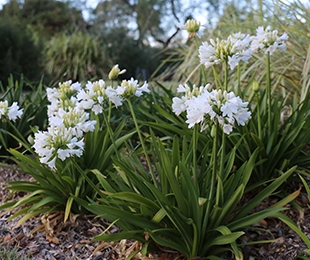
BINGO WHITE™ is a bright white flowering Agapanthus, for more information Click Here
Click to download the full Agapanthus hybrid – Bingo White™ Product Guide
Click to see where you can purchase / buy online the Bingo White™
Buccaneer™

BUCCANEER™ is a Purple Agapanthus with unique white with purple striped flower heads, for more information Click Here
Click to download the full Agapanthus hybrid – BUCCANEER™ Product Guide
Click to see where you can purchase / buy online the Buccaneer™
Agapanthus for Sale – Buy Online
Agapanthus plants are a beautiful addition to any garden, and at Ozbreed, we have a wide variety of Agapanthus plants for sale.
Whether you’re looking for Agapanthus ‘Bingo Blue’ or Agapanthus ‘Queen Mum’, we have the perfect plant for you. To order online, simply search through our selection of online retailers to find the plant you’re interested in and follow the instructions to complete your purchase.
